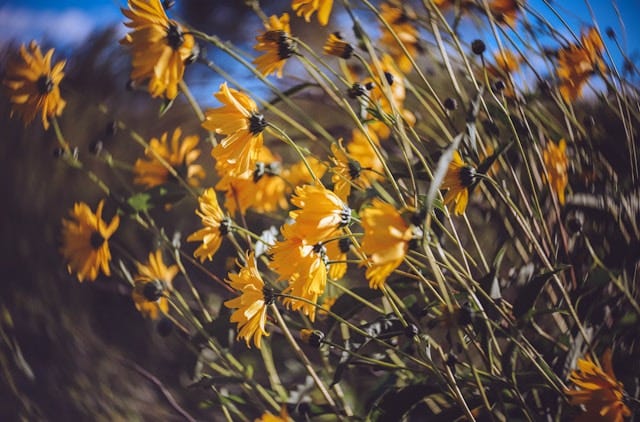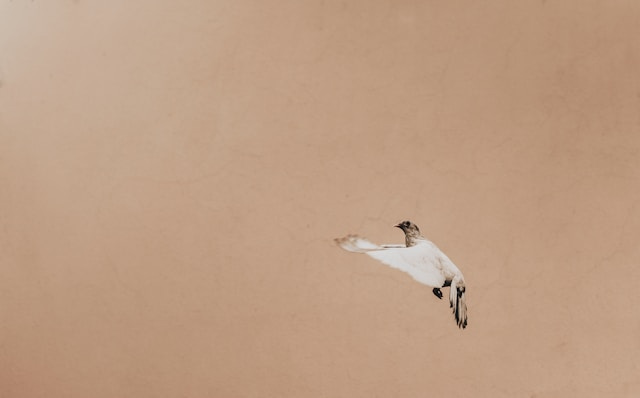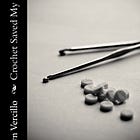How Craft Fits Into the Slow Living Movement
Slow Yarn, Mindfulness Crochet, Pomo Basket Weaving and more ...
The first version of this article on slow crafting originally appeared on the PsychCentral blog Crafting to Heal which I wrote in 2019. I’ve been very intrigued lately by looking back at my work over the years and finding threads and common themes, often things I’d forgotten about. For example, my Georgia O’Keeffe double exposure photos … In this case, I realized that I’d seen this show on Pomo Basket Weaving and then later went to an art exhibit featuring some baskets from this community and I hadn’t really recalled at the exhibit how I’d seen and written about this work before. So I’ve woven some of that in here (pun acknowledge). I’ve also pulled together some other writing I’ve done about slow crafting over time to complete this article.
Many people want to embrace a slower, more conscious way of life. You’ve probably felt the strong urge to get away from the distraction-heavy fast-paced activity of our always-on world. Of course, most people don’t want to get off the grid entirely. We just all want a little bit more spaciousness in our lives. We want areas of life where we can connect to ourselves, others, and nature.
Craft is the perfect way to introduce slowness into your everyday life.
Craft in America: Pomo Basket Weaving
I recently started watching the show Craft in America on PBS. I can’t believe I didn’t know about this show before now. It’s already in its tenth season. As soon as I saw the first episode of season ten, I became a fan.
The episode’s theme is California crafters. One of the makers who is profiled is a woman from the Pomo Indian tribe who has taken up her culture’s traditional basketry. Even in just her fifteen-minute segment, she touches upon so many different ways that craft heals her.
Most poignantly, she shares how her region was devastated by the fires that have been sweeping through the state over the past several years. She talks about how basketweaving helps with the healing process of such a terrible loss.
The Slow Art of Pomo Basket Weaving
What really stood out to me, though, was the way that she described the process of making the baskets. I learned that she grows and harvests her own materials. It is a long process.
First, the plants need to grow from their seeds. Then she needs to harvest them, which means breaking each piece down into smaller and smaller pieces for use in the baskets. Furthermore, the materials have to dry. Therefore, what she harvests today she might not use until next year.
By the time she actually starts weaving the basket, more than half of the work is done.
Elem Pomo Baskets on Exhibit
An excerpt from the article I wrote upon seeing the Elem Pomo baskets on display at de Young Museum.
Prior to the 19th century, these baskets were made by native people for native people. Then they became popular among non-native people and native people sold their baskets to outsiders. It’s a complicated part of history. On one hand, the devastation to the land and culture is undeniable and there’s a clear story at play when non-native people come to the land, destroy it, then want to collect souvenirs from the local people to display in their homes. On the other hand, these sales also speak to the power and resiliency of the Elem Pomo people; making and selling baskets was a creative and empowering way to make money that also preserved their creative cultural traditions.
Today, though, things are different once again. The hours it takes to make a basket to sell are simply too many to translate to making a viable living. So, the Elem Pomo people are once again making baskets for themselves. These are labors of love, gifts given at special points in a member’s life. In order to make these baskets, the people have to work closely with nature, tending to the plants they use for their creations, and doing so is one way of both sustaining and celebrating their cultural traditions.
What is The Slow Movement?
Most people have heard of the Slow Food Movement. In reaction to the problems inherent with fast food, people wanted to commit to slow food. Slow food means eating local, traditional, in-season foods. The more that you can grow with your own hands, the more connected you are to your meal.
Food isn’t the only area of life where you can embrace the concepts of the slow movement, though. You can take a slow living approach to almost any area of life. The primary goals are:
Slow down and be mindful.
Know where your items come from.
Put your own handmade effort into each element of a process.
Think sustainable, organic, eco-friendly, low-processed or no-processed
What Slow Movement Means in Crafting
Crafting is the ideal way to start embracing a slower way of life. After all, the very nature of the act is a way of slowing down.
For example, you could go buy a sweater. You might not know where it came from or how it was made. If it’s a piece of fast fashion, you might throw it away after a few uses. On the other hand, you could make your own sweater. Simply the act of knitting, crocheting, weaving, or sewing it yourself slows the whole process down. You become more connected to the piece.
You can also take the slow movement to the next level in your crafts. You do this by getting as involved as possible in each step of the process. In the aforementioned example, the basketweaver harvests her own plants. Another example would be a knitter who raises her own sheep, spins their wool into yarn, dyes the yarn herself with plant dyes from her own garden, and then finally knits with that yarn.
Slow Yarn
I’ve also written specifically about Slow Yarn; here’s an excerpt from a related book review:
Slow yarn, like the slow food movement, refers to engaging in yarn crafting mindfully and sustainably. It’s part of an overall sustainable lifestyle. And it celebrates doing things by hand. Crochet and knitting are already slow crafts. After all, it takes a lot longer to create a handmade sweater than it does to just go buy one. However, you can extend that into a longer, more involved slow yarn process.
For example, in the book Unraveling, author Peggy Orenstein shares her slow yarn story. She first learns how to shear a sheep, which is no easy task. After learning, she shears enough to collect wool to make a sweater. She cleans the wool. Then she learns how to spin it. After that, she learns how to dye it. Finally, she is ready to knit it into a sweater. That’s an example of slow yarn.
Wool isn’t the only fiber that you can use to knit or crochet. In fact, there are many other great natural fibers that offer various benefits when crafting. Cotton is a favorite choice when making lightweight summer clothes as well as kitchen towels. Therefore, you can incorporate gardening into a slow yarn movement of your own. Cindy Conner’s book “Homegrown Flax and Cotton” is all about this.
Here’s something else I wrote about this topic:
Slow yarn isn’t just about the materials, though; it’s about a way of thinking. Compare the practice of crocheting your own shirt to popping into a store and buying one for $10. Your mind is in a completely different place when crafting your own items, a place that is more mindful. The same is true if you slow things down even further by first spinning and dyeing the yarn you use before you even get to crocheting with it. All of this allows you time for contemplative crafting, which means that you are able to slow down and really live in alignment with your personal principles. It’s likely that, you are already a big step of the way there since you crochet. Consider how it might help the world if you take another big step in the direction of sustainable fashion and home design.
How to Slow Down Crafting
Although you may not do every part of the process yourself, you can slow it down and make conscious choices every step of the way.
Grow and process as many of your own materials as possible.
When buying materials, source them locally with sustainability in mind.
Get to know the people who supply you with materials for your craft.
Take the time to learn the history of your craft.
Learn how to do one more step in the craft process. For example, dye your own fabric before sewing.
How to Relax with Mindfulness Crochet
I’ve written a lot about using crochet for mindfulness practice, including creating mindfulness exercises for my books Crochet Saved My Life and Hook to Heal. Here’s one example:
. Read through the instructions first. Then find a calm area in your home to try it.
Choose a crochet hook and yarn – something you enjoy working with.
Crochet a long chain. Then you will work a single stitch into each chain. You can choose any basic crochet stitch that you like – I like half double crochet but single crochet, double crochet, whatever feels good for you.
Focus the entirety of your attention on crocheting one loop at a time. The goal is to focus on each detail of each stitch, counting each stitch as you go.
Do not let any other thoughts seep in although they will try. The monkey mind is like that.
Each time that you notice a thought, frog the crochet chain back to the beginning of the row, and start over.
Why Craft Slow
Slow living offers many different benefits. People who have concerns about the environment or the effects of chemicals will enjoy that slow crafting allows more control over materials.
The biggest mental health benefit of slow crafting is the sense of connectedness it provides you. You can connect with your own inner self, higher self, and true desires. The more you slow down and work with your hands, the quieter the noise in your head. The less you ruminate, and the less you allow for distractions, the easier it will be to know your own true self.
Here are some other reasons to craft slow:
Contribute to a more sustainable and mindful lifestyle
Connect to oneself, others, and nature
Cultivate patience and perseverance
Cultivate spaciousness in life
Deepen appreciation for the craft process
Develop a sense of accomplishment and pride
Embrace a slower, more conscious way of life
Engage in contemplative crafting
Enhance creativity and self-expression
Escape distraction-heavy, fast-paced activities
Experience a sense of connectedness and inner peace
Foster a sense of community and belonging
Foster mindfulness and mental well-being
Heal through the craft process
Promote ethical consumption and production practices
Promote sustainability and eco-consciousness
Reduce stress and anxiety
Support local artisans and traditional crafts
Sustain and celebrate cultural traditions
If you read this far, perhaps you liked the work. The work does take work. It only continues with support, so please consider subscribing. My annual rate starts at $10 per year.














A lovely hymn to the slow life. I have zero craft aptitude, but this was really interesting. I find I'm trying to embrace slowness more and more.